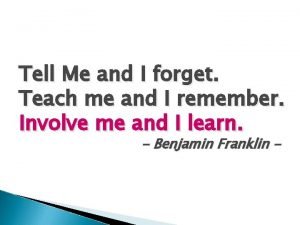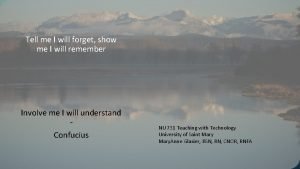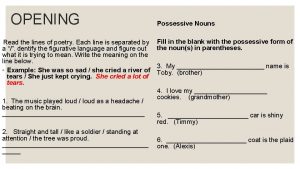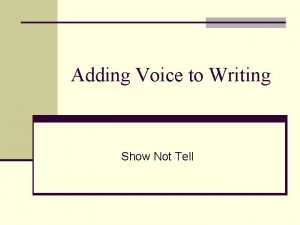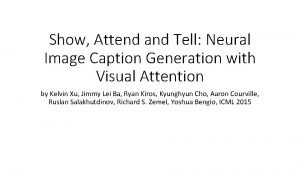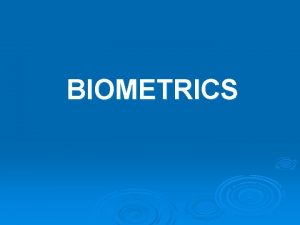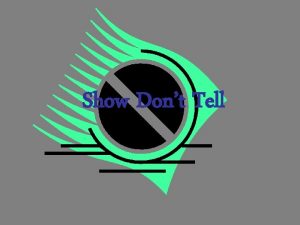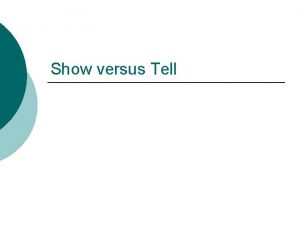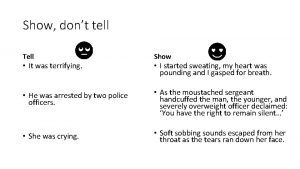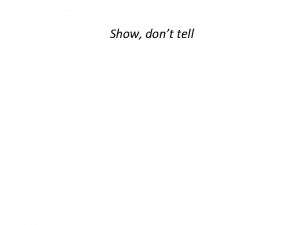Tell me I will forget show me I










- Slides: 10

Tell me I will forget, show me I will remember Involve me I will understand - Confucius NU 731 Teaching with Technology University of Saint Mary. Anne Glasier, BSN, RN, CNOR, RNFA

Course objectives for NU 731 I will show I met each of these objectives by course requirements as listed on each page: • Evaluate the compelling societal impetus for integrating technology in nursing education in the evolving knowledge era. • Examine concepts and theories related to teaching with technology. • Investigate technologies such as electronic health records (EHRs) that promote patient safety and care quality. • Correlate the changing healthcare and educational environments to the transformation of nursing education. • Describe clinical technologies that focus on faculty tools used to guide students in safe, efficient use of clinical technologies and accompanying caring behaviors. • Analyze simulated clinical learning experiences while focusing on teaching methods required to help students apply critical thinking and safety competencies. • Explore skills needed to provide safe patient care in today’s fast-paced, technology enhanced health care settings. • Demonstrategies for teaching with technology based on best practice evidence.

Evaluate the compelling societal impetus for integrating technology in nursing education in the evolving knowledge era. Nursing requires critical thinking skills (CTS) which can be related to the nursing concept based approach. Using a comic to gain the student’s attention would be the first of the Gagne’s nine levels of gain the attention of the students with the definition of CT in nursing reinforcing learning for recognition of how CTS produce evidence-based practice (EBP). Using a rubric in a debriefing of situations to assist students to understand utilizing P. Benner’s Novice to Expert Theory criteria to evaluate the critical thinking ability that the nursing students exhibits (Gantt, 2010). All these situations have shown utilization and integration of technology in nursing classrooms.

Using algorithm's to assist novice nursing students to understand theories that apply critical thinking and problem solving. Examine concepts and theories related to teaching with technology. Investigate technologies such as electronic health records (EHRs) that promote patient safety and care quality.

Evidence-Based Practice (EBP) in Nursing Education Describe clinical technologies that focus on faculty tools used to guide students in safe, efficient use of clinical technologies and accompanying caring behaviors. Utilizing EBP in students identification of research articles should or should not be used as the basis for EBP changes for nursing plan of care. Correlate the changing healthcare and educational environments to the transformation of nursing education. Faculty and librarians while working together can help students obtain information for evidence-based research which is the foundation of the best-practices requirement for nursing practice. As nursing instructors, it is imperative that we educate students on identifying research that is foundationally sound and competently applied to patient care with the full agreement of the patient. While researching information for enhancing critical thinking, several ideas have repeatedly been reinforced in many articles; having students use guided unfolding case studies, and simulations (Wane & Lotz, 2013; Kong, Qin, Zhou, Mou, & Gao, 2013; Chan, 2013) as well as written assignments and group discussion, debates and reflective thinking on difficult ethical issues (Lewis, Rogers, & Naef, 2006; Dickerson, 2005; Walker, 2003; Simpson & Courtney, 2002).

Analyze simulated clinical learning experiences while focusing on teaching methods required to help students apply critical thinking and safety competencies. There are many different ways that I see Facebook and You. Tube utilized in education (all be it that Facebook concerns me. ) The difficulty comes when discerning when the information is actually correct. Just today I found a great post on Facebook in a video that asked if you know what to do when someone is having a clonic-tonic seizure that was posted by Epilepsy Ottawa (Epilepsy Ottawa, 2017) and I verified the information with the CDC’s site (Center for Disease Control and Prevention [CDC], n. d. ). While this is not a formal teaching situation, it does give the general population what to do in this situation (and a bystander asking all the things you should not do) showing how correct information can be disseminated to a large group of people. However, many of the informational (and I use this term loosely) videos and posts are incorrect, or even dangerous and passed on and on without verification of the information. Using a fact-checking website such as the newly created Fact. Check. org, Politifact, or Snopes may help with finding ‘fake news’ or information. Problems like this are the reason utilizing Facebook is so difficult, let alone all the HIPPA violations that can occur for healthcare professionals. One area that I found that has some useful information (although, finding reputable sources just like finding suitable information for citing for papers and posts) is You. Tube videos can be very educational. Many colleges or educational institutions put out fantastic videos that can help visual and auditory learners grasp information easier or more rapidly by seeing or hearing concepts thereby have a greater breadth of learning opportunities for students, as well as students with disabilities or special needs such as dyslexia or hearing or vision difficulties possibly using closed captioning as an option (Bonnel & Smith, 2010).


Demonstrategies for teaching with technology based on best practice evidence. Explore skills needed to provide safe patient care in today’s fast-paced, technology enhanced health care settings. In the article by Boctor (2013), it was played in groups of students who discussed the correct answer, once the answer was given there was time for debate or facilitation by the instructor/game-show host. The research that was done showed that the students found the activity for reviewing materials before the test for a fundamentals of nursing course. “Playing ‘Nursopardy’ required students to think critically, work together and analyze other students’ contribution as noted in educational games’ research” by the author. (Boctor, 2013, p. 99). I chose to add an EBP column with corresponding questions and answers. Thereby adding a game that could be incorporated into both a EBP, and CT setting.

This video summarizes how EBP, CT, and Reflective Thinking all are involved in problem solving in Nursing and Nursing Education.

References Boctor, L. (2013). Active-learning strategies: The use of a game to reinforce learning in nursing education. A case study. Nurse Education in Practice, 13, 96 -100. http: //dx. doi. org/10. 1016/j. nepr. 2012. 07. 010 Bonnel, W. E. , & Smith, K. V. (2010). Teaching technologies in nursing and the health professions: Beyond simulation and online courses. New York, NY: Springer. Center for Disease Control and Prevention. (n. d. ). Seizure First Aid. Retrieved from https: //www. cdc. gov/epilepsy/basics/firstaid. htm Corteza, P. (2015, March 2). Decision making in Nursing [Video file]. Retrieved from https: //www. youtube. com/watch? v=5 Z 3 pli. Tis 7 w Epilepsy Ottawa. (2017, March 21). If you saw someone have a tonic-clonic seizure, would you know what to do? [Facebook page]. Retrieved https: //www. facebook. com/Epilepsy. Ottawa/videos/10154684259784317/? pnref=story Gagne, R. (1985). The Conditions of Learning (4 th ed. ). New York: Holt, Rinehart & Winston. Gantt, L. T. (2010). Using the Clark Simulation Evaluation Rubric with associate degree and baccalaureate nursing students. Nursing Education Perspective, 31(2), 101 -105. Retrieved from http: //web. a. ebscohost. com. stmary. idm. oclc. org/ehost/detail? vid=4&sid=e 0 d 7233 e-76 e 6 -48 c 0 -af 663 af 056 eaca 1 e%40 sessionmgr 4010&hid=4206&bdata=Jn. Npd. GU 9 ZWhvc 3 Qtb. Gl 2 ZQ%3 d%3 d#AN =105182443&db=ccm Rathbun, M. C. , & Ruth-Sahd, L. A. (2009, July). Algorithmic tools for interpreting vital signs. Journal of Nursing Education, 46(7), 395 -400. http: //dx. doi. org/10. 3928/01484834 -20090615 -07 Wayne, G. (2015). Nursing research NCLEX practice quiz #1 (20 questions). Retrieved from https: //nurseslabs. com/nursing-resear-quiz-20 -items/ Webber, H. (2015, February 3). Critical thinking in nursing [Video file]. Retrieved from https: //www. youtube. com/watch? v=k 5 alam-wh. V 8
 Tell me and i forget show me and i remember
Tell me and i forget show me and i remember Tell me i will forget
Tell me i will forget Show not tell paragraph
Show not tell paragraph Tell me and i forget
Tell me and i forget Tell me and ill forget
Tell me and ill forget Tell me what you eat and i shall tell you what you are
Tell me what you eat and i shall tell you what you are Show don't tell writing exercises
Show don't tell writing exercises Show not tell for excited
Show not tell for excited Show not tell in writing
Show not tell in writing Show don't tell examples
Show don't tell examples Show attend and tell
Show attend and tell
